Wrought Iron vs Cast Iron: Key Differences, Applications, and Benefits Explained
2025-04-22 14:32:28 hits:0
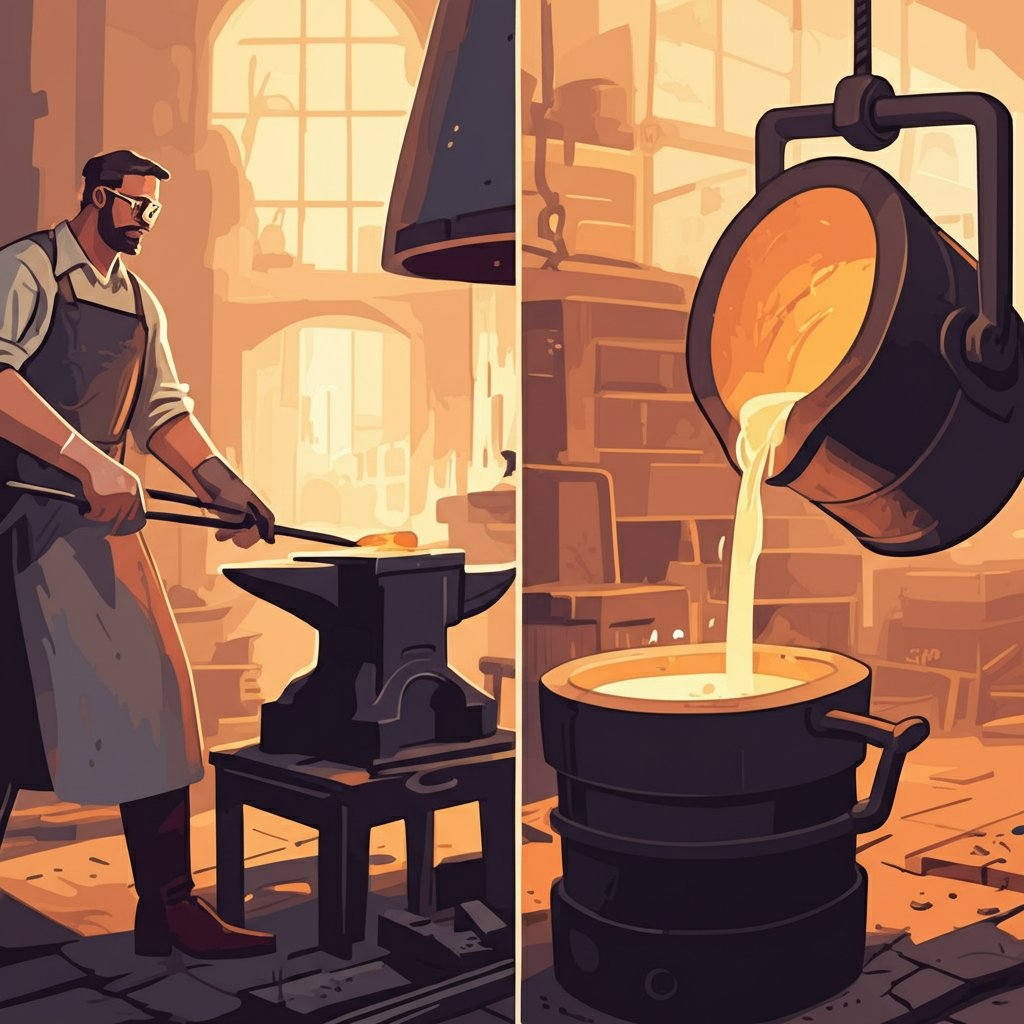
Introduction: Understanding Wrought Iron vs Cast Iron
Ever wondered why some garden fences last for generations, while others seem to rust or break within a few years? Or why your favorite skillet feels so different from the ornate railings on historic buildings? The answer often lies in the fundamental difference between wrought iron and cast iron—a distinction that shapes how these materials look, perform, and endure over time.
At first glance, both materials might seem interchangeable. But dig a little deeper, and you’ll notice that their origins, compositions, and strengths set them apart in ways that matter for homeowners, builders, and anyone passionate about craftsmanship. Understanding the difference between wrought iron and cast iron not only helps you choose the right material for your next project, but also gives you a new appreciation for the ironwork you see every day.
Wrought iron is created by heating iron and working it with tools—think of a blacksmith hammering and shaping metal while it’s hot. This process gives wrought iron its signature fibrous texture, high malleability, and toughness.
Cast iron, on the other hand, is made by melting iron, pouring it into molds, and letting it solidify. The result is a material that’s hard and excellent for intricate shapes, but more brittle and less flexible than wrought iron.
Historically, these differences influenced everything from architecture to cookware. Wrought iron’s durability and workability made it the go-to for gates, fences, and structural supports well into the 19th century. Cast iron, with its ability to be poured into complex forms, revolutionized mass production—especially for items like stoves, pipes, and decorative elements.
So, why does this comparison matter today? Choosing between wrought iron vs cast iron affects not just the look and feel of your project, but its longevity, maintenance needs, and even safety. Whether you’re restoring a historic home, selecting outdoor furniture, or investing in cookware, knowing the strengths and limitations of each material sets you up for long-term success. In the following sections, we’ll break down their properties, uses, and benefits—so you can make informed choices with confidence.
Reference: Reliance Foundry: Wrought Iron vs Cast Iron
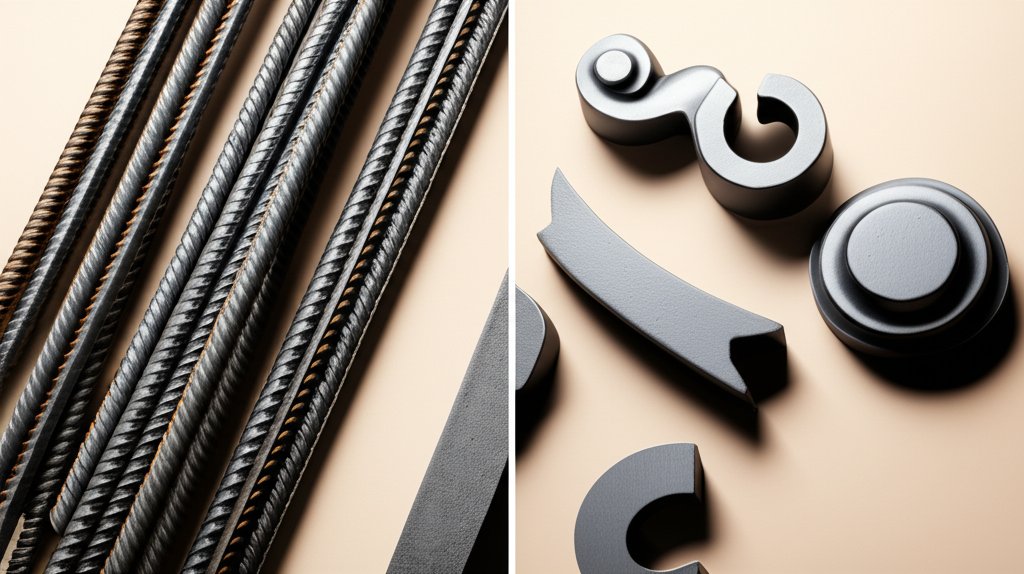
The Key Differences Between Wrought Iron and Cast Iron: Carbon Content, Manufacturing, and Structure
When you’re choosing between wrought iron and cast iron, it’s easy to get lost in the technical jargon. But the real distinction comes down to how each material is made, their carbon content, and the way these factors influence their strength and everyday performance. Let’s break it down so you can see exactly how these two iconic forms of iron stack up—and why those differences matter for your next project.
How Are They Made? A Look at Manufacturing Processes
Imagine watching a blacksmith hammer glowing metal into shape—that’s the essence of wrought iron. In contrast, picture molten iron being poured into a mold to cool and harden into a specific form—that’s cast iron in action. These two methods create materials with unique properties, suited for very different uses.
| Aspect | Wrought Iron | Cast Iron |
|---|---|---|
| Manufacturing Process | Heated and repeatedly worked with tools—hammered, rolled, and shaped while hot. This process increases strength and creates a fibrous texture. | Iron is melted, mixed with alloys and impurities, then poured into molds and allowed to solidify. Minimal working after casting. |
| Typical Carbon Content | Very low: about 0.1% carbon, plus 1–2% slag (silicon, sulfur, phosphorus, aluminum oxides). | High: generally 2–4% carbon, with small amounts of silicon, manganese, and other impurities. |
| Material Structure | Fibrous, with visible slag inclusions; highly malleable and ductile. | Crystalline, heterogeneous microstructure; hard but brittle, not easily shaped after casting. |
| Strengths | High tensile strength, excellent fatigue resistance, can be reheated and reshaped. | Good compressive strength, excellent for complex shapes, high hardness and abrasion resistance. |
| Corrosion Resistance | Relatively good due to slag content—forms a patina that protects against rust. | Lower; needs protective coating (like paint) to prevent rusting. |
| Repairability | Can be welded, reheated, and repaired easily. | Difficult to weld or repair; more prone to cracking if stressed. |
Why Does Carbon Content Matter?
You might wonder, what’s the big deal about carbon? The wrought iron vs cast iron carbon content is a game-changer. Wrought iron’s low carbon makes it softer, tougher, and more flexible. That’s why it can be bent, twisted, or hammered without breaking—perfect for ornate railings or gates. Cast iron’s high carbon, on the other hand, makes it harder and better at holding intricate shapes, but also more brittle. Drop a cast iron pan, and you risk a crack; try the same with wrought iron, and you’ll likely just get a dent.
Real-World Impact: What These Differences Mean for You
Customization: Need something unique or decorative? Wrought iron is easier to work into custom shapes by hand.
Complex Designs: Cast iron is ideal for mass-producing detailed, repeatable forms—think park benches or engine blocks.
Durability: Wrought iron resists fatigue and can flex under pressure, while cast iron stands up to heavy loads but may fracture if bent or dropped.
In summary, the wrought iron vs cast iron manufacturing process and their carbon content create two very different materials. Your choice will depend on whether you value flexibility and repairability, or hardness and the ability to produce complex shapes. Next, we’ll dive deeper into how these properties translate into real-world strength and durability, so you can make the most informed decision for your needs.
References: Metal Supermarkets: Wrought vs Cast Iron, Reliance Foundry: Wrought Iron vs Cast Iron
Strength and Durability: How Wrought Iron and Cast Iron Compare
When you’re deciding between wrought iron and cast iron, the question often comes down to which material will hold up best over time. Sounds complex? Let’s make it simple by breaking down wrought iron strength and cast iron durability—and what that means for your next project.
How Strong Is Wrought Iron?
Imagine a material that can bend without breaking, yet still stand up to years of use. That’s the hallmark of wrought iron. Thanks to its low carbon content and fibrous internal structure, wrought iron is highly malleable and ductile. This means it can be hammered, twisted, or shaped into intricate designs—perfect for custom gates, railings, and decorative features. Its tensile strength is impressive, often reaching up to 300 MPa, which rivals some modern steels(Metal Supermarkets). Because it can flex under stress, wrought iron is less likely to crack or snap when subjected to repeated motion or impact.
What About Cast Iron’s Durability?
Now, picture a material that’s tough as nails but doesn’t like to be bent. Cast iron is celebrated for its hardness and ability to withstand heavy loads. Its high carbon content (2–4%) gives it a crystalline structure, making it great at resisting abrasion and compressive forces. That’s why you’ll see it in applications like engine blocks, heavy-duty pipes, and even cookware. However, its rigidity is a double-edged sword: while it won’t deform easily, it can be brittle and prone to cracking if struck sharply or exposed to rapid temperature changes(Crescent Foundry).
Corrosion Resistance: Who Wins?
Both materials can resist corrosion, but in different ways. Wrought iron naturally forms a protective patina thanks to its slag content, which slows down rusting—even outdoors. Cast iron, on the other hand, generally needs a protective coating, like paint, to keep rust at bay. If left unprotected in damp environments, cast iron can corrode more rapidly.
Pros and Cons: Wrought Iron vs Cast Iron at a Glance
Wrought Iron Pros:
High tensile strength—can bend without breaking
Excellent flexibility and fatigue resistance
Good natural corrosion resistance (forms protective patina)
Easy to repair and reshape
Wrought Iron Cons:
Not as strong under compression as cast iron
Requires regular maintenance to maximize lifespan outdoors
Generally more expensive due to labor-intensive production
Cast Iron Pros:
Outstanding compressive strength—ideal for heavy loads
High hardness and abrasion resistance
Durable in static, high-pressure applications
Lower cost for mass-produced items
Cast Iron Cons:
Brittle—can crack under impact or rapid temperature change
Less flexible; not suited for applications involving repeated motion or bending
Requires protective coating to prevent rust
Difficult to repair if damaged
So, when should you choose one over the other? If your project calls for something that can flex, endure repeated use, or requires custom shapes, wrought iron is the way to go. But if you need a material that’s tough, holds up under heavy pressure, and can be cast into complex forms, cast iron delivers on durability. Next, we’ll see how these differences play out in outdoor furniture—where weather, style, and maintenance all come into play.
References: Metal Supermarkets, SI Handrails, Crescent Foundry
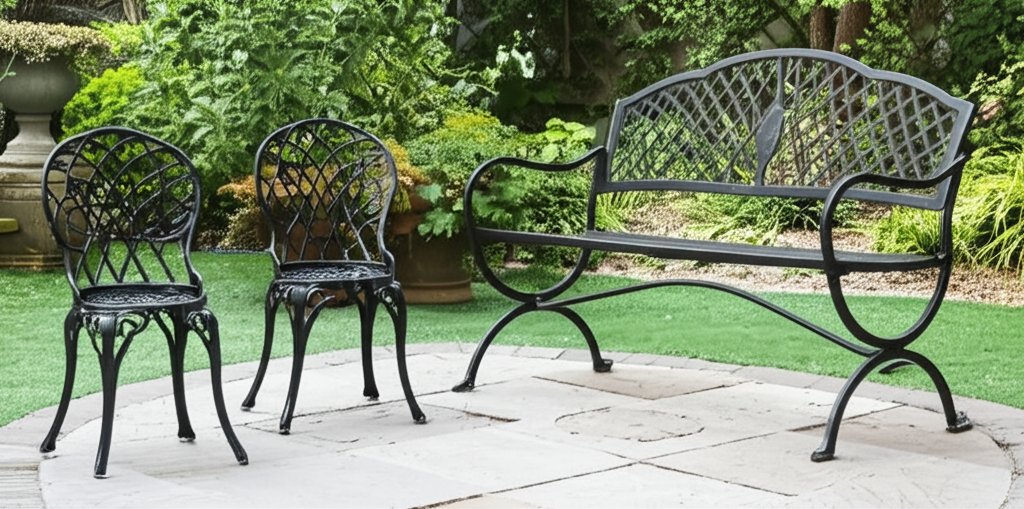
Choosing the Right Iron for Outdoor Furniture: Wrought vs Cast Iron
Picture this: You’re relaxing on your patio, enjoying a sunny afternoon. The furniture beneath you feels sturdy, looks elegant, and stands up to the changing seasons. But what’s the secret behind truly lasting outdoor furniture? The answer often lies in the choice between wrought iron vs cast iron outdoor furniture. Let’s explore what sets these two apart when it comes to durability, style, and everyday care.
Durability: Which Lasts Longer Outdoors?
When you invest in outdoor furniture, you want it to withstand everything from blazing sun to pouring rain. Cast iron is celebrated for its toughness and weight—making it stable in windy conditions and highly resistant to wear. However, its high carbon content can make it brittle, which means it may crack if dropped or struck sharply. Wrought iron, in contrast, is more flexible and less likely to break under stress. Its malleable, fibrous structure allows it to bend rather than snap, which can be a big advantage for furniture that sees regular use or needs to be moved around the yard(IronStone).
Aesthetics and Design Versatility
Imagine wanting a garden bench with intricate scrollwork or a set of chairs that matches your unique sense of style. Wrought iron is the go-to for custom, ornate designs. Its flexibility allows artisans to create everything from delicate curves to bold, modern lines. Cast iron, on the other hand, is best for detailed, repeatable patterns—think classic Victorian motifs or robust, geometric shapes. Both offer a timeless look, but if you crave customization, wrought iron gives you more options.
Maintenance: Keeping Your Furniture Looking Its Best
Outdoor furniture faces constant exposure to the elements, so maintenance is key. Here’s a quick comparison to help you decide which material fits your lifestyle and upkeep preferences:
| Feature | Wrought Iron | Cast Iron |
|---|---|---|
| Weather Resistance | Resists rust with proper coating; forms a protective patina over time. Should not be left in standing water. | Highly resistant to wear; needs protective paint to prevent rust. Heavy weight helps in windy weather. |
| Design Versatility | Highly customizable; can be shaped into intricate and modern designs. | Best for detailed, mass-produced patterns; less flexibility for custom pieces. |
| Maintenance Needs | Requires regular cleaning, inspection for scratches or chips, and occasional touch-up paint. Store or cover when not in use for best results(Today's Patio). | Needs periodic repainting to prevent rust; inspect for cracks, especially if exposed to impact. Heavy weight makes moving and maintenance more challenging. |
| Ease of Movement | Lighter than cast iron, easier to rearrange. | Very heavy; stable, but difficult to move. |
Wrought iron is ideal if you want flexible design, easier movement, and are willing to commit to moderate maintenance for long-term beauty.
Cast iron suits those prioritizing stability, classic patterns, and don’t mind a bit more effort when it comes to repainting and moving heavy pieces.
Ultimately, the choice between wrought iron and cast iron for outdoor furniture comes down to your priorities—whether it’s style, ease of care, or how often you plan to rearrange your patio. Up next, we’ll dive into how these same qualities play out in the kitchen, especially when it comes to cookware performance and everyday use.
References: IronStone, Today's Patio
Wrought Iron in the Kitchen: Why It's Preferred for Cookware
When you reach for a skillet to sear a steak or sauté vegetables, have you ever wondered why some pans feel lighter, heat up faster, or just seem easier to maneuver? That’s where the debate of cast iron vs wrought iron pan comes alive in the kitchen. Let’s explore why more chefs and home cooks are turning to wrought iron cookware—and how it can change the way you cook.
Heat Conductivity and Cooking Performance
Imagine you’re preparing a delicate omelet or trying to achieve the perfect sear on a piece of fish. The pan’s ability to quickly and evenly distribute heat makes all the difference. Wrought iron stands out here—its superior conductivity means it heats up faster and more evenly than cast iron. This not only saves you time but also ensures you get consistent results every time you cook. In fact, wrought iron cookware requires less energy to reach the desired temperature, making it a more efficient choice for eco-conscious cooks(Solidteknics).
Wrought iron: Rapid, even heating; less energy needed; ideal for quick temperature adjustments.
Cast iron: Slower to heat; retains heat well but can develop hot spots; takes longer to cool down.
Weight and Ease of Handling
Ever struggled to lift a heavy cast iron pan, especially when it’s full? You’re not alone. Wrought iron pans are typically about half the weight of comparable cast iron pans, making them much easier to handle, especially for those with limited strength or mobility. This lighter weight doesn’t mean you sacrifice cooking power—wrought iron still holds heat well, allowing for excellent searing and browning.
Wrought iron: Lighter weight; easier to lift, pour, and maneuver; accessible for cooks of all ages.
Cast iron: Heavy and cumbersome; can be difficult to move, especially when hot or loaded with food.
Handle Comfort and Safety
Have you ever burned your hand on a hot pan handle? Cast iron pans usually feature short, thick handles that quickly become hot during cooking. In contrast, wrought iron cookware often includes longer, ergonomically designed handles that remain cooler, thanks to better heat dissipation. This design makes it safer and more comfortable to use on the stovetop.
Wrought iron: Long, vented handles stay cooler and provide better grip and control.
Cast iron: Short, thick handles absorb heat and can be uncomfortable or unsafe to touch.
Material Purity and Health Considerations
Did you know the purity of your pan’s material can affect your food? Wrought iron cookware is made from nearly pure iron (up to 99.7%), while many cast iron pans are produced from recycled materials that may contain trace heavy metals. This difference not only impacts performance but also gives peace of mind to those seeking non-toxic, health-conscious cookware(Solidteknics PDF).
Wrought iron: High purity; low risk of heavy metal contamination; better for non-toxic cooking.
Cast iron: May contain impurities from recycled materials; potential for leaching if not properly maintained.
Summary: Why Wrought Iron Shines in the Kitchen
Superior heat conductivity for faster, more even cooking
Lighter weight makes handling and cleaning easier
Cooler, ergonomic handles improve safety and comfort
High material purity for healthier, long-lasting cookware
Less prone to cracking or breaking under thermal shock or impact
So, next time you’re comparing wrought iron cookware to cast iron, consider what matters most in your kitchen—ease of use, performance, or peace of mind. As we move outdoors, you’ll see how these same qualities can influence your choice of iron for garden and patio spaces as well.
Outdoor Living: The Impact of Cast Iron vs Wrought Iron on Your Space
When you picture your dream garden or patio, do you imagine delicate scrollwork benches or robust, classic silhouettes? The decision between wrought iron vs cast iron garden furniture shapes not only the look of your outdoor space but also how it functions and endures. Let’s break down what makes each material unique for outdoor living, so you can choose furniture that matches your lifestyle and design vision.
Design Versatility: Which Iron Sparks More Creativity?
Imagine wanting a statement piece—a bench with intricate curves or a table that feels truly one-of-a-kind. Wrought iron is celebrated for its malleability, allowing artisans to bend, twist, and shape it into elaborate, custom designs. Whether your taste leans toward ornate Victorian scrolls or sleek modern lines, wrought iron offers unmatched creative freedom for outdoor use(Hauser's Patio). Cast iron, by contrast, is poured into molds, making it perfect for repeating detailed patterns and bold, classic motifs. If you prefer uniformity and traditional shapes, cast iron delivers reliable, timeless forms.
Longevity and Everyday Functionality
When you invest in outdoor furniture, you want it to last through seasons of sun, rain, and gatherings. Here’s what you’ll notice about each option:
Wrought iron: Its fibrous, low-carbon structure means it can flex slightly without snapping, making it resilient to regular movement and minor impacts. With proper maintenance, wrought iron can last for decades, gracing historic gardens and modern patios alike(Crescent Foundry).
Cast iron: Known for its weight and hardness, cast iron furniture is extremely stable—great if you live in a windy area or want pieces that stay put. However, its brittleness means it can crack if dropped or struck, and it’s less forgiving if you need to move it frequently.
Maintenance: Keeping Your Furniture Looking Its Best
Outdoor iron furniture faces rain, sun, and the occasional spilled drink. Here’s how each material stacks up for upkeep:
Wrought iron: Needs regular cleaning, touch-up paint, and protective coatings to keep rust at bay. Its lighter weight makes seasonal storage or rearrangement easier. The good news? Modern rust-proof paints and sealants make maintenance simpler than ever(Hauser's Patio).
Cast iron: Requires periodic repainting and careful inspection for cracks, especially after impacts. Its heavy weight makes moving or storing it more challenging, but also means it’s less likely to tip over in storms.
Key Considerations for Homeowners and Landscapers
Style preferences: Choose wrought iron for intricate, personalized designs; cast iron for classic, repeatable patterns.
Climate: Both resist weather well with proper care, but cast iron’s weight is a plus in windy regions, while wrought iron is easier to move for storage or cleaning.
Maintenance commitment: Both require upkeep, but wrought iron’s lighter weight and flexibility make repairs and seasonal care more manageable.
Longevity: With regular maintenance, both materials can last for decades—wrought iron often outlives cast iron in high-movement or impact-prone areas.
So, as you plan your outdoor oasis, think about how you’ll use your space, your design goals, and how much time you want to spend on maintenance. Whether you lean toward the artistry of wrought iron or the steadfastness of cast iron, your choice will shape your garden’s beauty and function for years to come. Next, we’ll explore how these differences translate into cost and long-term value for your home projects.
References: IronStone, Crescent Foundry, Hauser's Patio
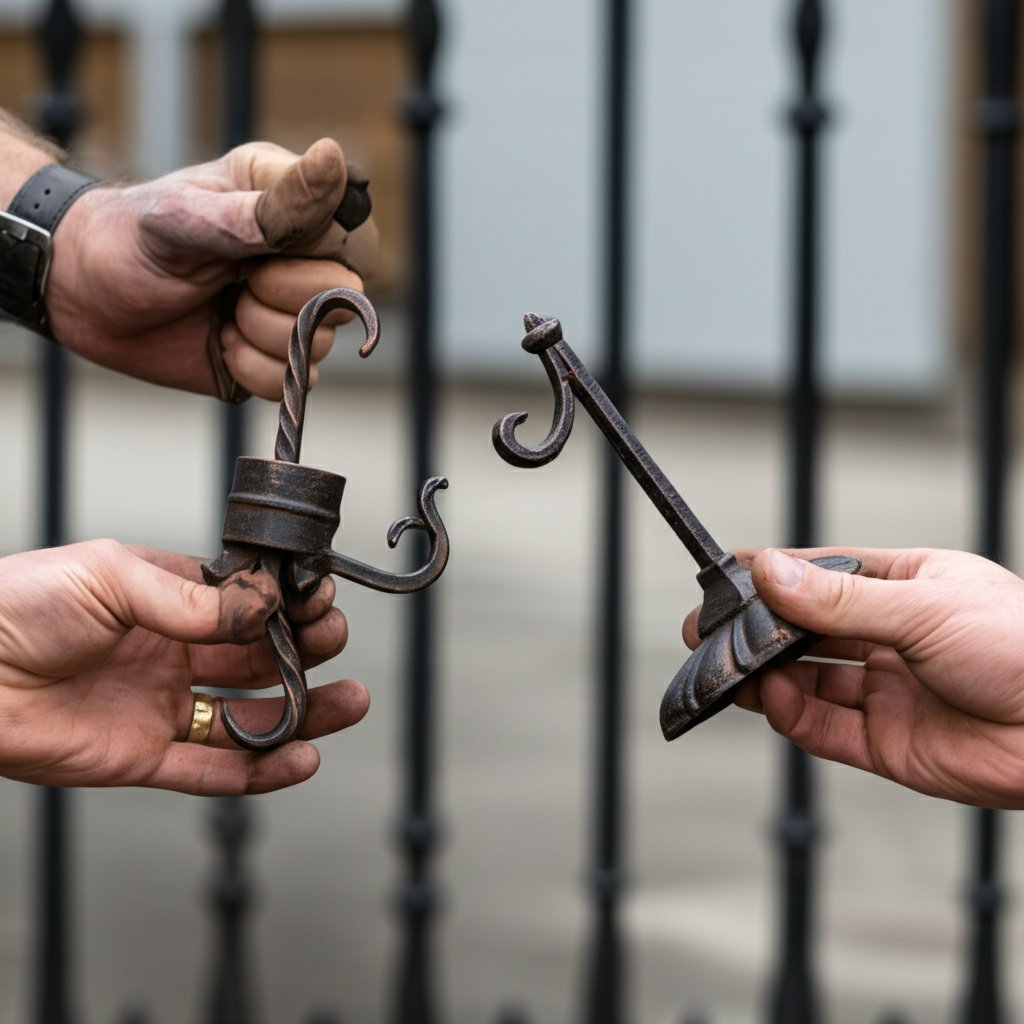
Cost Comparison: Wrought Iron vs Cast Iron for Home Projects
When planning a home project—be it a decorative fence, handrail, or custom furniture—budget is always top of mind. You may have wondered: which is more expensive, cast iron or wrought iron? The answer isn’t always straightforward, but understanding the true wrought iron vs cast iron cost can help you make a smart, long-term investment. Let’s break down what really drives the price of each material, and how those costs play out over the life of your project.
Why Does Wrought Iron Usually Cost More?
Imagine you’re designing a custom gate with intricate scrollwork. If you choose wrought iron, you’re paying not just for the raw material, but for skilled craftsmanship. Each piece is hand-forged by a blacksmith, shaped with heat and hammer, and finished to your specifications. This labor-intensive process makes wrought iron generally more expensive than cast iron, which is produced by pouring molten metal into molds—a much faster and less hands-on process(Garon Fence).
Wrought iron: Higher labor costs, especially for custom or detailed designs. Each project is unique, with significant time and skill invested.
Cast iron: Lower labor costs due to mass production. Molds allow for faster, repeatable manufacturing, making it more affordable for large or intricate patterns.
Material, Installation, and Upkeep: What to Expect
Material cost is just the beginning. Installation and long-term maintenance also affect your total investment. Here’s a quick comparison to help you see the bigger picture:
| Cost Factor | Wrought Iron | Cast Iron |
|---|---|---|
| Initial Material & Labor | High—hand-forged, custom work; each piece unique | Lower—mass produced, mold-based; less customization |
| Design Complexity | Costs rise with intricate, bespoke designs | Complex designs affordable if mass-produced in molds |
| Installation | May require specialized labor | Generally simpler, but heavy pieces can increase labor costs |
| Maintenance | Needs regular cleaning, painting, and rust protection; easier to repair if damaged | Requires periodic repainting; can be harder to repair if cracked; less frequent but more difficult repairs |
| Longevity & Value | Extremely durable; often outlasts cast iron; can increase property value | Durable but more brittle; may need replacement if damaged; classic look but less flexibility for repairs |
Real-Life Example: Custom Fencing
Let’s say you’re installing a fence. Wrought iron will typically have a higher upfront cost, especially if you want a one-of-a-kind design. Cast iron, on the other hand, is more budget-friendly for standard or mass-produced patterns. However, if a section of cast iron fencing cracks, replacing it can be more challenging and potentially costly than repairing a bent or rusted wrought iron section(SI Handrails).
If you value longevity, unique design, and easier repairs, the extra investment in wrought iron may pay off long-term.
If you’re prioritizing initial savings and want a classic look, cast iron can be a practical choice—especially for large-scale or less customized projects.
In summary, the true cost of wrought iron vs cast iron depends on your priorities: upfront budget, design goals, and willingness to maintain your investment. As you weigh your options, consider not just the price tag, but the value each material brings to your home over time. Next, we’ll see how these cost factors influence large-scale applications in construction and automotive industries, where performance and durability drive the decision-making process.
References: Garon Fence, SI Handrails
Wrought Iron and Cast Iron in Construction and Automotive Industries: Performance, Uses, and Industry Trends
When you look at iconic bridges, sturdy building frameworks, or the brake rotors in your car, you might wonder: why choose one type of iron over another? The answer lies in the distinct roles that wrought iron vs cast iron in construction and cast iron automotive applications play, driven by their unique strengths and manufacturing methods. Let’s break down where each material shines, what performance traits set them apart, and how industry preferences have evolved.
Wrought Iron in Construction: Where Workability Meets Heritage
Imagine the intricate gates of a historic estate or the hand-forged railings on a city landmark. Wrought iron, with its low carbon content and fibrous structure, has been a favorite for applications where malleability and tensile strength matter most. Its ability to be repeatedly heated, bent, and shaped makes it ideal for custom, decorative, and structural elements—especially in restoration or specialty projects.
Common construction applications for wrought iron:
Decorative gates, fences, and railings
Historic building restoration (balconies, window grilles)
Custom architectural hardware
Structural tie rods and braces in heritage buildings
While modern construction has largely shifted to steel for large-scale frameworks, wrought iron remains unmatched for artisanal, small-batch, or restoration work where authenticity and hand-craftsmanship are valued(Reliance Foundry).
Cast Iron in Construction: Strength for Static Loads and Complex Shapes
Now, picture a Victorian-era lamp post or a sturdy sewer grate. Cast iron’s high carbon content (2–4%) gives it excellent compressive strength but makes it brittle. That means it’s perfect for components that need to bear heavy, static loads and can be easily cast into complex or repeatable shapes.
Common construction applications for cast iron:
Columns and posts in older buildings
Manhole covers, grates, and drainage pipes
Decorative façade elements and lamp standards
Engineered parts where mass production is needed
Although steel now dominates most structural roles, cast iron is still widely used for architectural features, infrastructure, and site furnishings where durability and detailed casting are priorities(Industrial Metal Supply).
Cast Iron in Automotive Applications: The Backbone of Brakes and Engines
When it comes to vehicles, cast iron has long been a staple—especially for components that demand high wear resistance and vibration damping. Even as automakers seek lighter materials, cast iron remains essential for certain parts:
Key automotive uses for cast iron:
Brake rotors and drums (gray iron for its damping properties)
Engine blocks and cylinder liners (where durability is crucial)
Exhaust manifolds (withstand high temperatures)
Suspension and steering components (such as knuckles and bearing caps)
While some parts are now made from aluminum or other alloys to reduce weight, cast iron continues to comprise a significant portion of automotive hardware, particularly for brake systems and heavy-duty engine parts. Its ability to be cast into precise, complex shapes at scale keeps it relevant in modern manufacturing(Metal Casting Institute).
Wrought Iron in Automotive and Modern Engineering
Though less common in today’s automotive sector, wrought iron’s legacy lives on in specialty and historical vehicle restoration, where its ductility and resistance to fatigue are prized. For most modern engineering needs, mild steel or advanced alloys have replaced wrought iron, but its influence is still felt in custom, artisanal, or period-correct projects.
Industry Preferences and Modern Solutions
So, how do construction and automotive industries decide between wrought and cast iron? It’s all about matching the material’s strengths to the application—wrought iron for flexibility and hand-crafted design, cast iron for mass-produced strength and wear resistance. As industries evolve, the demand for high-quality castings and specialized iron components only grows.
For businesses seeking reliable, high-performance castings, it’s crucial to partner with a supplier that offers both technical expertise and a wide range of material options. TIEGU stands out with its advanced casting processes, extensive material selection (including both gray and ductile iron), and proven track record supplying precision parts for automotive, construction, and beyond. Their ability to deliver high-purity, custom-engineered castings—backed by large-scale production and global recognition—makes them a trusted choice for demanding industry applications. To learn more about TIEGU’s casting solutions and how they can support your next project, visit their casting solutions page.
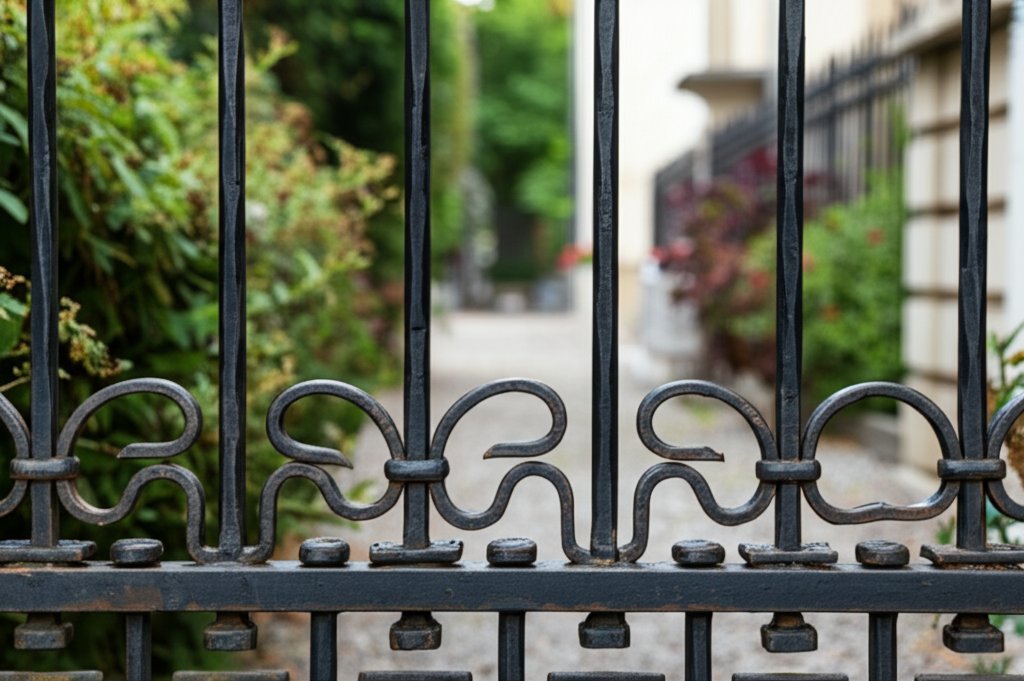
Long-Term Benefits: Why Choose Wrought Iron Over Cast Iron?
When you plan a project—whether it’s a garden gate, a balcony railing, or a statement staircase—you want your investment to last. But what really sets wrought iron apart from cast iron for longevity, ease of care, and lasting beauty? Let’s break down the benefits of wrought iron so you can see why it’s often the material of choice for those who value both form and function.
Durability That Stands the Test of Time
Imagine a railing that weathers decades of rain, sun, and daily use—without losing its strength or charm. That’s the promise of wrought iron. Thanks to its low carbon content and fibrous internal structure, wrought iron is naturally tough, flexible, and able to absorb impacts without cracking. Unlike cast iron, which can be brittle and prone to sudden fractures under stress, wrought iron tends to bend rather than break, offering a built-in resilience that’s hard to match(WOZO).
Wrought iron vs cast iron longevity: Research and real-world examples show that wrought iron installations often outlast cast iron by decades, especially in outdoor or high-traffic settings.
Even if minor damage occurs, wrought iron can be easily repaired or restored, extending its useful life further.
Low Maintenance, High Value
Wrought iron is surprisingly easy to maintain. A well-made piece requires only occasional cleaning and, if used outdoors, a fresh coat of paint or protective finish every several years. Its natural resistance to rust—thanks to embedded slag fibers—means it won’t deteriorate as quickly as cast iron, which demands more frequent upkeep to prevent corrosion(Signature Metal Works). Even if rust does appear on wrought iron, it takes years to compromise its structural integrity, and touch-ups are usually straightforward.
Minor scratches or chips are easily fixed with a wire brush and paint.
Galvanized or powder-coated finishes can make outdoor wrought iron virtually maintenance-free for decades.
Aesthetic Flexibility and Lasting Appeal
Want a piece that’s both functional and beautiful? Wrought iron’s malleability allows artisans to craft intricate, custom designs—whether you love minimalist lines or ornate scrollwork. Over time, these pieces don’t just endure; they often become more charming, developing a subtle patina that adds character without detracting from structural integrity. This timeless elegance can even boost your property’s value and curb appeal(Signature Metal Works).
Endless design possibilities—bend, twist, and shape to fit any style or space.
Retains beauty and function for generations, with many historic examples still in use today.
Key Reasons to Opt for Wrought Iron
Unmatched durability and flexibility—bends, doesn’t break
Longer lifespan than cast iron in most applications
Lower maintenance needs and easier repairs
Timeless, customizable aesthetics that add value
Ideal for projects where safety, beauty, and longevity matter most
So, when you’re weighing wrought iron vs cast iron longevity and value, imagine a material that keeps its strength and style year after year—with less worry and more design freedom. Next, we’ll wrap up with a summary and expert guidance to help you choose the perfect iron for your next project.
Conclusion & Expert Solutions: Wrought Iron vs Cast Iron Expert Advice for Every Project
After exploring the ins and outs of wrought iron vs cast iron, you might still wonder: which is best for your unique needs? Let’s recap the essential differences, then look at how you can get the best casting solutions—no matter your project’s size or complexity.
Key Takeaways: Wrought Iron vs Cast Iron at a Glance
Wrought iron is nearly pure iron, expertly shaped by hand or machine. It’s known for its flexibility, resistance to rust, and ability to be repaired or customized. Perfect for decorative gates, railings, and any application demanding both beauty and strength.
Cast iron is poured into molds, resulting in a dense, hard, and often heavier product. Its high carbon content gives it outstanding compressive strength and heat retention, making it the go-to for cookware, engine parts, and architectural elements that require mass and stability.
Choosing between them depends on your priorities:
If you want custom designs, flexibility, and longevity—wrought iron is usually your best bet.
If you need affordable, mass-produced parts with excellent heat or load-bearing properties—cast iron delivers unbeatable value.
How to Decide: Expert Advice for Your Material Selection
Still unsure which iron suits your project? Consider these questions:
Is your project decorative or structural?
Will the item face frequent movement, impact, or weather?
Do you prioritize ease of repair, or is low upfront cost more important?
Are you looking for unique, one-of-a-kind pieces, or standardized parts?
For tailored guidance, consulting with casting experts is always a smart move. They can help you weigh the pros and cons based on your exact requirements—saving you time, money, and future headaches.
Why Trust TIEGU for the Best Casting Solutions?
When you need reliable, high-quality castings—whether it’s for automotive, construction, industrial, or decorative use—TIEGU stands out as a global leader. Here’s why:
Diverse material options: From gray and ductile cast iron to cast steel and aluminum alloy, TIEGU covers nearly every casting need.
Advanced casting processes: Sand casting, precision casting, die casting, and more—ensuring the right method for your specific application.
Large-scale capacity and global reach: With an annual output exceeding 1.2 million tons and partnerships across industries, TIEGU is equipped for projects big and small.
Industry recognition: Trusted by major automotive, rail, and engineering companies for precision parts and custom solutions.
Customer-focused support: TIEGU’s 24/7 service team and expert engineers provide seamless communication and technical advice from start to finish.
Whether you’re designing a historic restoration, sourcing parts for manufacturing, or planning a unique architectural feature, expert advice makes all the difference. Ready to get started? Connect with TIEGU’s casting professionals to discuss your project and discover the best casting solutions tailored to your needs. With the right partner, you’ll ensure your ironwork is built to last—combining quality, performance, and peace of mind.
Frequently Asked Questions about Wrought Iron vs Cast Iron
1. What is the main difference between wrought iron and cast iron?
The main difference lies in their manufacturing and composition. Wrought iron is heated and shaped with tools, resulting in a fibrous, flexible structure with low carbon content. Cast iron is melted and poured into molds, producing a hard, brittle material with higher carbon content. These differences affect their strength, durability, and best-use scenarios.
2. Which is more expensive, cast iron or wrought iron?
Wrought iron is generally more expensive due to the labor-intensive forging process and custom craftsmanship. Cast iron, produced via mass casting in molds, is more cost-effective for large-scale or standardized projects. However, wrought iron may offer better long-term value thanks to easier repairs and longer lifespan in many applications.
3. Why is wrought iron preferred for certain outdoor and decorative uses?
Wrought iron is favored for outdoor and decorative projects because of its flexibility, ease of repair, and ability to be shaped into intricate designs. Its natural resistance to rust and its durability make it ideal for gates, railings, and custom garden furniture, especially where unique aesthetics and longevity are priorities.
4. How does cast iron perform in automotive and construction applications?
Cast iron excels in automotive and construction thanks to its high compressive strength and ability to be cast into complex shapes. It's widely used for engine blocks, brake rotors, pipes, and architectural features that require durability and mass production. Its hardness and wear resistance are key advantages in these industries.
5. What are the long-term maintenance needs for wrought iron and cast iron products?
Wrought iron typically requires regular cleaning and occasional repainting but is easier to repair if damaged. Cast iron needs protective coatings to prevent rust and can be more difficult to fix if cracks occur. Both materials benefit from routine inspection, especially in outdoor settings, to ensure longevity.

 en
en  fra
fra  de
de  ru
ru  ara
ara  gle
gle  it
it  jp
jp  kor
kor  th
th  zh
zh 


